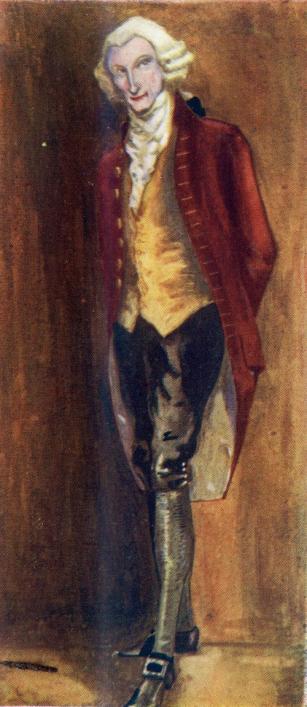Remembering 1780
13th November 2018
From Ferdinand Brock Tupper's History of Guernsey, printed by Stephen Barbet, New Street, Guernsey, 1854, p. 434. 'From the MS of a Guernsey jurat, now deceased, written in 1839 or 1840, we extract the following:'
‘A few alterations in things within my recollection, that is, with in sixty years, or since 1780, when I was 12 years old, and first went to school in England.
Dress for men. Powder was universally worn, with a tail or a club, which I found most troublesome. Cocked hats, except for boys, who sometimes wore round. Buckles, which by kicking made my shins very sore. Short breeches with knee buckles, often leather with top boots. No Wellington trousers or boots; no morning frock coats; although the body coats were much longer than the present ones, and waistcoats were much longer than they are now made. No black or coloured cravats.
Dress for women. Powder universal, commonly of the reddish cast, with high head dresses. (The powder tax of Pitt did more for the beauty and ornament of women than all the mantua-makers and hair-dressers in the world.) Hoops in common use, when dressed out. Long waists, and uncovered bosoms and arms. High heels to the shoes, which made the women shocking walkers. More silk than cotton dresses. Chintzes common.’
Shipping. The merchant ships are much larger and finer now than at the period, and they were then never coppered. The king’s ships are perhaps even more improved, and the sailing of both has kept pace with these improvements; but there was a class of vessels which, when a boy, were my admiration, and I could never cease gazing upon them—I mean the cutters and luggers,—the Resolution, cutter privateer, with many others; the Alarm, lugger, was also a beauty; and the smugglers, with their athletic crews, who looked and lived like gentlemen. How many happy hours they made me pass, by merely looking at them. That hardy race is gone by, and is, it would seem, extinct; for even the present luggers and cutters are no more to be compared to them than the old ships of war to the present ones.—Smuggling, with all its faults, had its advantages too, as it created and kept up a bold race of seamen.
Improvements. The great improvements in my time are the recent ones of steam-boats, railroads, gas, and so many in the comforts of life, produced by the instruments of steam, that it is impossible to enumerate them. Small windows, low roofs, and small apartments were the chief evils of dwelling houses; but they had one convenience which I now always miss—fixed seats to the windows. In furniture, no sofas, and most uncomfortable chairs with straight backs. No silver forks, knives bad, small spoons, and very small tea cups though more frequently of real China than are now to be found. Bread, shocking in the island. The white wines drunk were Mountain and Lisobon; good Port; little good Claret, and no Champagne. No hot-house fruits, or evergreens; but beautiful flowers in abundance,—I think more so than at present; and fruit, I should say, was also more abundant—peaches, nectarines, golden pippins, and codlins: the two last are nearly extinct.
Society. There was much more conviviality than at present. As proof of this, the number of clubs. Especially of the ladies. Cards were more in fashion, and the hours of meeting conduced more to society. We dined at one, and I believe that two or three was the hour for company. The New Ground and the Pier, of a Sunday, were much more brilliant than they are now, notwithstanding our mighty improvements. Our public walks are so deserted that one would often be tempted to believe there was no-one left in the island. The many clubs then in the country for gentlemen are another proof of the difference of the times. I believe our ancestors were happier and wiser then ourselves, notwithstanding our boastings and the march of intellect which we so modestly assume.’
The image is from a book in the Library Collection, English Costume, Painted and Described by Dion Clayton Calthrop, London: Adam & Charles Black, 1907.
